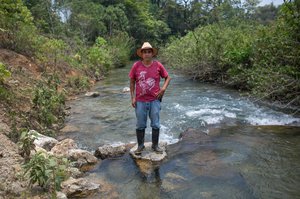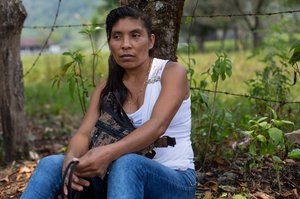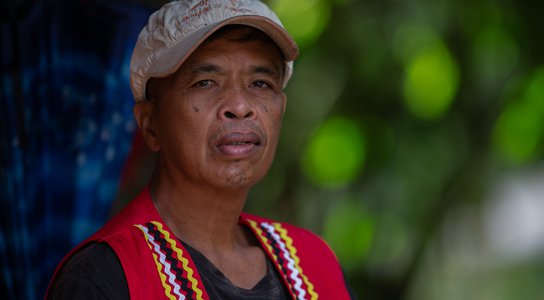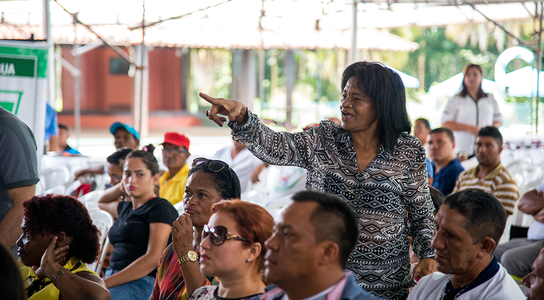To mark World Indigenous Peoples’ Day 2019, we tell the story of one Guatemalan community’s struggle to protect their home.
Juana Grisela Manuel’s family have lived on their community’s ancestral lands in western Guatemala for generations. But ever since construction started on a state-backed hydropower project on the nearby river, the land and water they rely on has been slowly poisoned.
“We can’t go fishing anymore, the rivers are already polluted,” the 16-year-old told Global Witness. “It’s not like before. The soil needs fertilizer now. Food like corn and beans no longer grows. We sow, yes, but we do not harvest anymore.” - Juana Grisela Manuel
Juana’s family is not alone. Many of the people in the Ixquisis region of San Mateo Ixtatán have spoken about the impact on their lives by the two hydroelectric dams which are being built across the Yal Witz River that snakes through the region’s verdant hills.
But instead of having their concerns heard, the community’s opposition to the development has been met with years of harassment and often violent attacks by police, soldiers and security guards.
In January 2017, a 72-year-old man was shot dead during a protest. In October the following year, hundreds of armed police attacked community members during another demonstration, injuring at least six people. Two months later, the bodies of brothers Neri and Domingo Esteban Pedro, who had campaigned against the project, were found dumped on the riverbank with bullets in their heads.
Our ancestors relied on this river. I will continue defending my land, my rivers, my forest, my mountains and my hills. If I am going to die doing that, well…. - Sebastián Juan Hernández

Community meeting in the Ixquisis region of San Mateo Ixtatá.
UNDER ATTACK
Their fate is emblematic of a worsening trend for people defending their land and our environment in Guatemala.
Research by Global Witness shows at least 16 Guatemalans were killed in 2018 - up from three in 2017 - making it the world’s deadliest country per capita for defenders last year.
But these deadly attacks are just the tip of the iceberg. Across Guatemala, land and environmental defenders who are resisting forced evictions, land grabs and pollution from dams, mines, and agriculture are being targeted by state and corporate forces, with a cocktail of physical and legal attacks.
Globally, more than three people were killed on average every week in 2018 defending their land and the environment from industries like mining, logging and agribusiness. Countless more were silenced through other tactics designed to crush protest, such as death threats, arrests, lawsuits and smear campaigns.
The true number of killings was likely much higher, because cases are often not documented and reliable evidence is hard to find and verify.

Lucas Jorge Garcia, president of the local community development committee, and member of the Ixquisis Peaceful Resistance against the San Mateo Hydroelectric Project, poses for a photo along the Negro River.
INDIGENOUS PEOPLE
Indigenous communities are disproportionately impacted by violence against land and environment defenders.
Last year around a quarter of those killed were indigenous, even though indigenous peoples make up only five per cent of the world’s population. And that is at the low end: most years that Global Witness has been keeping records, that number has been around 40 per cent.
Those land and environmental defenders who stand up for their rights are also more likely to be attacked and criminalised.
Like Enrique Fernández, an indigenous leader who had a bomb left outside his house in Colombia, where a third of the 24 defenders killed in 2018 were indigenous.
Or like members of the Unist’ot’en tribe in Canada, who were slapped with lawsuits for protesting against a gas pipeline on their land.
Governments should ensure that any investment on indigenous areas should fulfill the international obligation of free, prior and informed consent; at the same time, dissent should be protected of any form of retaliation. - Claudia Samayoa, UDEFEGUA
Often violence follows a well-worn path. UN Special Rapporteur on the Rights of Indigenous Peoples Vicky Tauli-Corpuz says that attacks tend to start with smear campaigns labelling indigenous people as “anti-development” or “terrorists.” This leads to arrests and legal charges, or being thrown in jail without a trial. These assaults can escalate further, culminating in brutal beatings, sexual assaults or even murder.
Indigenous defenders are particularly vulnerable because they often lack legal titles to their homes. Indigenous and local communities customarily inhabit more than half the world’s land, but only have legal rights to 10 percent. Without these documents it is easier for the rich and powerful to silence their claims and evict them from their family homes – first with the stroke of a pen and later with batons or firearms.
Across Guatemala, land and environmental defenders who are resisting forced evictions, land grabs and pollution from dams, mines, and palm oil or sugar plantations are being targeted by state and corporate forces with a cocktail of physical and legal attacks that appear designed to silence voices that challenge their interests. - Alice Harrison, Senior Campaigner, Global Witness

Ercilia Perez Lopez, 38, from Bella Linda and member of the Ixquisis Peaceful Resistance against the San Mateo Hydroelectric Project, rests under a tree.
This week, for the first time in over a decade, the International Panel on Climate Change issued a stand-alone report on the role that land use plays in climate change.
The report elaborated on the role played by indigenous peoples and local communities in protecting large areas of pristine ecosystems – critical for saving the planet from climate breakdown.
It warranted an unprecdented reaction from a group of indigenous and community organizations and networks—representing 42 countries spanning 1.6 billion hectares of land, including 76 percent of the world’s tropical forest—issuing a statement highlighting the scientific evidence that they are the best guardians of the forest.
CORPORATE RESPONSIBILITY?
Much of the violence against indigenous people is driven by demand for land and natural resources to make the products we use every day.
Despite the presence of armed Government forces, people living in the Ixquisis region do not feel safe. On the contrary, this presence inspires them with fear. During a recent visit, women told us that they and their children do not live peacefully. That they can no longer walk calmly in those once dreamy roads, because now police men or soldiers can suddenly appear, blocking their path and scaring them. - Anabella Sibrián, International Platform against Impunity in Guatemala, Honduras, and El Salvador
All too often irresponsible businesses and corrupt or negligent governments are willing to ride roughshod over people’s lives in pursuit of profit.
The hydroelectric project that is destroying the Ixquisis communities’ homes in western Guatemala is run by a company called Energía and Renovación SA. Official records are sparse, but local groups have uncovered evidence that it is owned two of the most influential families in Central America, the Mata Monteros and Mata Castillo families.
Global Witness was unable to verify this in official company documents because information on beneficial owners isn’t included, but Jose Guillermo Mata Monteros has represented the company at a number of public events, two of which cited him as E&R SA’s director.

Brothers Nery and Domingo Esteban Pedro were found dumped on the banks of the Yal Witz River with bullets in their heads. Both men were vocal opponents of a hydropower project.
The project has also received millions of dollars from the Central American Bank for Economic Integration and the Inter-American Development Bank. Germany’s development bank KfW has also provided US$15 million via the Infrastructure Crisis Facility Debt Pool.
These international investors, that have provided millions of dollars in finance to the San Andres and Pojom II hydroelectric projects should have a better handle on the people and organisations they finance. Read the full details of this case in our report here.
If the rights of land and environmental defenders are being violently shut down rather than respected, they should pull their money out.
For Juana and her community, however, the price of the project is paid in blood and tears.
You might also like
-
Report Enemies of the State?
More than three people were murdered each week in 2018, with countless more criminalised, for defending their land and our environment.
-
Press release Spotlight on Criminalisation of Land and Environmental Defenders
Global Witness report highlights use of terrorism laws and aggressive legal attacks by powerful elites to crush protest
-
Briefing What Businesses & Governments can do for Defenders
Governments, companies and investors can play an important role in supporting defenders